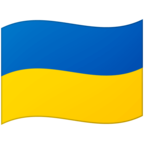🇺🇦 Flag: Ukraine Emoji
🇺🇦 Emoji Information
- Name:
- Flag: Ukraine
- Short Codes:
- :flag_ua:
:ua: - Keywords:
- flag, Ukraine
- Category:
- Flags » Country Flag
- Introduced:
- 2010
- Unicode Codepoint(s):
-
🇺U+1F1FA
🇦U+1F1E6
- Modifier:
- Not Available
🇺🇦 Flag: Ukraine Meaning
This emoji represents the flag for ukraine. On the windows platform, the emoji will show as the letters ua.
The flag: Ukraine emoji was introduced in 2010 and released as part of the Unicode 11.0 standard. This emoji can be found under the flags category. Because the flag: Ukraine emoji has been around for quite some time, it should display correctly in the majority of operating systems.
🇺🇦 Emoji on Different Devices
Here you'll find a range of emojis on how they will look using different operating systems.
Each company will design an emoji according to their own style. Here we have listed the most popular platforms around to see how the emoji will look on their screens.
Depending on the operating system version, the images may still look different to your display.
- Google

- Apple

- Facebook

- Twitter

- Windows

- Samsung

🇺🇦 Worldwide Trend
🇺🇦 Developer Codes
- Short Codes:
- :flag_ua:
:ua: - Hex Code:
-
🇺🇦 - Decimal Code:
-
🇺🇦 - Punycode:
-
xn--e77hhb - URL Escape Code:
-
%F0%9F%87%BA%F0%9F%87%A6 - JavaScript & JSON:
-
\ud83c\uddfa\ud83c\udde6 - CSS Code:
-
content: '\1F1FA \1F1E6';
